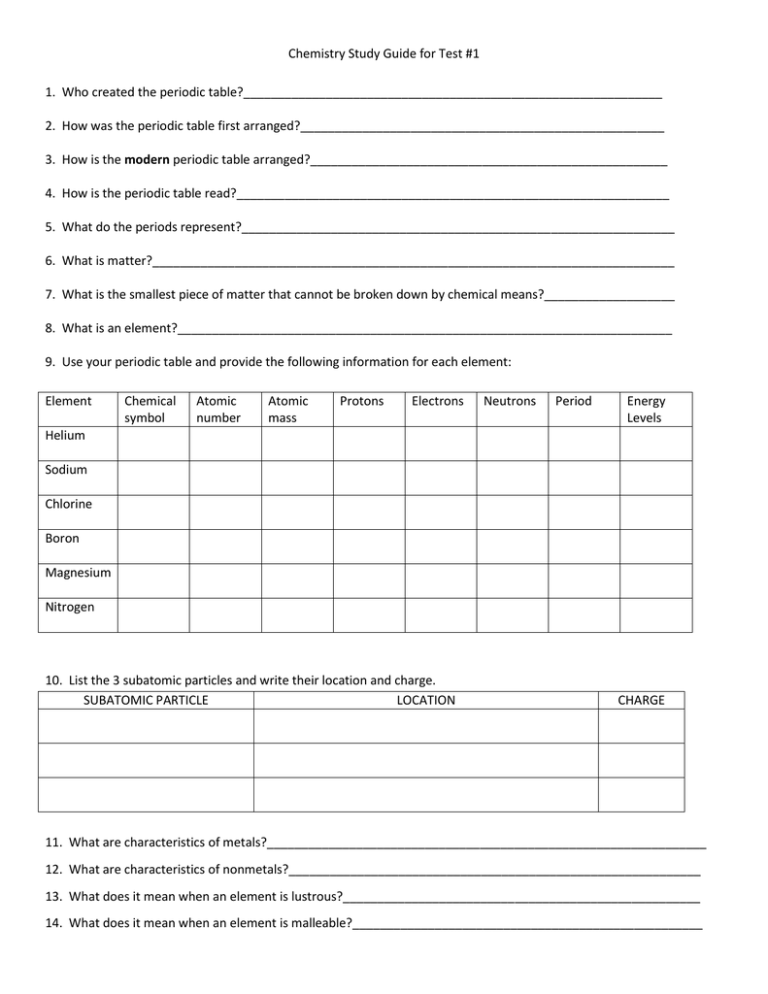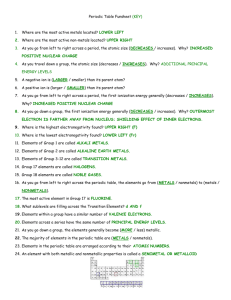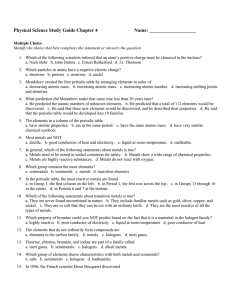Chemistry Study Guide for Test #1 1. Who created the periodic table
advertisement

Chemistry Study Guide for Test #1 1. Who created the periodic table?_____________________________________________________________ 2. How was the periodic table first arranged?_____________________________________________________ 3. How is the modern periodic table arranged?____________________________________________________ 4. How is the periodic table read?_______________________________________________________________ 5. What do the periods represent?_______________________________________________________________ 6. What is matter?____________________________________________________________________________ 7. What is the smallest piece of matter that cannot be broken down by chemical means?___________________ 8. What is an element?________________________________________________________________________ 9. Use your periodic table and provide the following information for each element: Element Chemical symbol Atomic number Atomic mass Protons Electrons Neutrons Period Energy Levels Helium Sodium Chlorine Boron Magnesium Nitrogen 10. List the 3 subatomic particles and write their location and charge. SUBATOMIC PARTICLE LOCATION CHARGE 11. What are characteristics of metals?________________________________________________________________ 12. What are characteristics of nonmetals?____________________________________________________________ 13. What does it mean when an element is lustrous?____________________________________________________ 14. What does it mean when an element is malleable?___________________________________________________ 15. Where are the most active metals located?__________________________________________________________ 16. Where are the most active non metals located?______________________________________________________ 17. Elements of Group 1 are called______________________________List some examples:_____________________ 18. Elements of Group 2 are called______________________________List some examples:____________________ 19. Elements of Group 3-12 are called______________________________List some examples:_________________ 20. Elements of Group 17 are called______________________________List some examples:___________________ 21. Elements of Group 18 are called______________________________List some examples:___________________ 22. As you go from left to right across the periodic table, the elements go from (metals/nonmetals) to (metals/nonmetals). 23. What do elements in the same group have in common?______________________________________________ 24. The majority of elements in the periodic table are (metals/ nonmetals). What fraction?____________________ 25. An element with both metallic and nonmetallic properties is called a____________________________________ 26. List the six elements (name and symbol) that display both metallic and nonmetallic properties.______________ _______________________________________________________________________________________________ 27. What are the possible masses for the following elements? Ti________, Ba________, Pb________, Ar________ 28. Rule #1 states that the ____________number = the number of ____________________. 29. Rule # 2 states, the Atomic_______________ = 30. Rule #3 states that # of protons # of neutrons = Atomic_________________ 31. Rule #4 states that # of ___________________ = + # of ___________________ - # of _____________________. # of _______________________. 32. What is a physical property?____________________________________________________________________ 33. List examples of physical properties.______________________________________________________________ _______________________________________________________________________________________________ 34. What is a chemical property?____________________________________________________________________ 35. Define Physical Change._________________________________________________________________________ 36. Define Chemical Change.________________________________________________________________________ 37. Tell whether each of the following is a chemical change or physical change. mixing salt and pepper________________________ evaporation of water __________________________ electrolysis of water ___________________________ cutting a marshmallow _________________________ toasting a marshmallow__________________________ burning magnesium _____________________________ demolishing a car _______________________________ the rusting of iron ______________________________ melting of sugar ________________________________ baking a cake _________________________________




